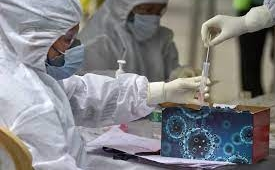New glowing Covid test prototype produces results in a minute

Tokyo, Jan 18: Japanese researchers have developed a new test that could quickly determine whether you have Covid-19 with a glowing chemical.
Using a molecule found in crustaceans, the team from Japan Science and Technology Agency (JST) developed a rapid approach that detects SARS-CoV-2 protein comparably to one used in vaccine research.
From fireflies to lantern fish, many animals possess the chemical tools to produce light. Typically, this reaction requires the substrate luciferin and the enzyme luciferase.
However, a class of less discriminating luciferins, known as imidazopyrazinone-type (IPT) compounds, can glow when encountering other proteins, including ones that aren’t considered enzymes, the researchers reported in the journal ACS Central Science.
Previous research suggests that IPT luciferins could serve as the basis for a new type of medical test that uses luminescence to announce the presence of a target protein in a specimen.
The team led by Ryo Nishihara and Ryoji Kurita from JST suspected that an IPT luciferin could react with the SARS-CoV-2 spike protein, which allows the virus particles to invade cells and cause Covid — and open the door to develop a glowing test.
The team first investigated 36 different IPT luciferins’ abilities to react with a single unit of spike protein. Only one molecule, which came from tiny crustaceans from the genus Cypridina, emitted light.
The researchers then tested the luciferin’s activity with the spike protein in its natural state, as three units folded together.
They found that, over the course of 10 minutes, an adequate amount of light could be detected.
A commercially available luminescence reading device was required; the light could not be seen by the naked eye.
Additional experiments indicated that the IPT luciferin was selective because it did not glow when exposed to six proteins that occur in saliva.
They define this specific luminescence reaction by non-luciferase biomolecules as “biomolecule-catalysing chemiluminescence (BCL)”.
Finally, the team found that the luciferin could detect the amount of the spike protein in saliva with the same accuracy as a technique currently used in vaccine development.
However, the luciferin system delivered results in one minute — significantly faster than the current rapid point-of-care tests.
This BCL-based approach could serve as the basis for a simple “mix and read” test in which the IPT luciferin is added to untreated saliva from someone suspected of having Covid-19, according to the researchers.
They note that a similar approach could be adapted to detect other viruses that possess spike-like proteins, such as influenza, MERS-CoV and other coronaviruses.
(IANS)






